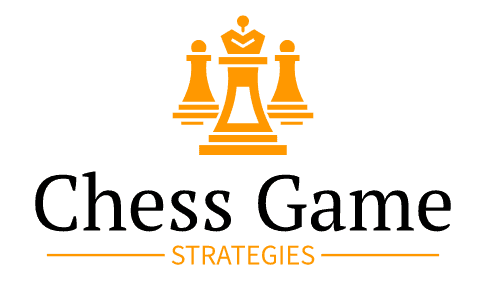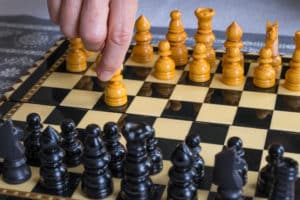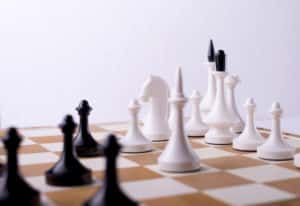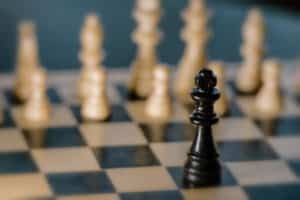
Chess Strategies Guide : Section 1 (Strategies)
Use Chess Strategies to create game plans for how you intend to manage the development of your army, while dealing with your opponent’s gameplay. Remember the quote from GM Max Euwe, World Chess Champion, 1935-1937:
“Strategy requires thought; Tactics require observation.”
With Strategies, your army becomes a cohesive unit, rather than an autonomous collective of 8 Pawns and 8 Pieces. The board takes on a new dimension – where there once were 64 meaningless squares, you suddenly see squares of greater and lesser importance, depending on the situation you face, at any point in your game.
Strategies can include:
- Choosing your Opening … how will you develop your Pawns and Pieces, ready for the action that takes place during the Middlegame phase?
- Knowing which side of the board to play on … for instance, your King has Castled Kingside, your opponent’s King has gone to the Queenside … which side of the board should you focus the majority of your army?
- Knowing which will be your important Pieces … these are the ones that will hopefully take you to victory. The others can be sacrificed / exchanged in the pursuit of the victory.
In the beginning, you may come up with a good strategy to beat some of your opponents. However, the very best players are able to fluidly switch between Strategies appropriate for the unique peculiarities of any given position in a game; they’re not stifled by a rigid set of ‘rules’; rather, they see the Strategies as a set of ‘best principles’, which help them coordinate attacks and deal with compromising situations.
Basic Chess Strategy
In this section, I’ve cobbled together a typical collection of assorted concepts to help you progress and learn the basics of the game.
This is more or less how I learnt to understand the relationship between the Pawns & Pieces during the three different phases of a game (Opening, Middlegame, Endgame).
Consider this a ‘warm-up’, to get your brain in gear, before you settle down with a brew, as you get stuck in with the more-comprehensive strategy guides, starting with Yasser Seirawan’s Winning Chess Strategies book, perhaps.
Point Count Chess
Point Count Chess (PCC) was a 1950s-1960s publication, devised by Israel Albert Horowitz and Geoffrey Mott-Smith (shortened to H&M-S, for my benefit) and has been hailed by some as one of the best books ever published, that deals with Chess Strategy.
This article contains reviews, both positive and negative about PCC, found on Amazon.com.
Finally, for what it’s worth, I give my opinion and reasons for making PCC the foundations of the Advanced Beginner’s Chess Guide, as its contents lead nicely onto looking at Chess Strategy.
Seirawan Opening Strategy
Nestled throughout his Winning Chess series of books, Grandmaster Yasser Seirawan gives a rough set of 6 Rules for managing the Opening Phase.
You can use the principles contained in this strategy, as a starting point, to help you reach the Middlegame Phase in the best possible shape.
There are 6 Steps in Seirawan’s Opening Strategy:
- Activate Your Troops;
- Build a House for your King;
- Castle Your King;
- Connect Your Rooks;
- Control the Center;
- and Obey the Rules of Strategy.
Material Advantages
This guide is based on my notes from studying Yasser Seirawan’s book, Winning Chess Strategies.
As the title suggests, you’ll find subjects concerning how to deal with a Material Advantage, as well as how defeat can be snatched from the jaws of victory by letting your Material Advantage slip through from your grasp!
Topics include:
- Overwhelming Your Opponent
- Throwing Away a Material Advantage
- Trading Pieces for a Winning Endgame
Stopping Enemy Counterplay
This guide is also based on my notes from studying Yasser Seirawan’s book, Winning Chess Strategies.
The purpose of the two strategies found in this guide is to make sure that you prevent enemy counterplay.
If your army is the Superior side, before you focus on attacking the enemy, you want to take the time to clamp down on any opportunities your opponent might have to get at your weaknesses, else they may become the dominant force on the board, which could crumble to dust the attack(s) you’d planned.
Topics include:
- Spotting Tactical Threats
- Keeping Your Opponent Helpless
Promoting Pawns To Win
A Pawn’s ability to gain Promotion is it’s ultimate trump card, changing this slow-moving, low-value squaddie into a Piece with whatever powers they possess. Often, the primary choice is to Promote to a Queen!
Topics include:
- Promotion — the standard goal of changing the Pawn to a Queen.
- Underpromotion — whereby you promote the Pawn to either a Knight, Bishop, or Rook.
This guide also links to:
- Rule of the Square, which helps to determine whether a Pawn has a chance of reaching its Promotion square, before the enemy King can get across to capture it!
Weak Pawns As Targets
This guide is also based on my notes from studying Yasser Seirawan’s book, Winning Chess Strategies.
Because Pawns are slow to move, restricted in how they can move, and often end up with their forward path being blocked, they make for ideal targets to attack!
Pawns are strongest when they have other friendly Pawns to support them (they can move into a Chain formation, for instance). But why would you want to waste time, effort and precious resources trying to take-out a strong target?
You’re much better off going for the easy meat: the vulnerable Pawns; the helpless Pawns; the Weak Pawns, such as “Backward Pawns”, “Pawn Islands”, “Isolated Pawns”, “Doubled Pawns”, “Tripled Pawns”, and “Hanging Pawns”
Topics include:
- Acceptable Doubled Pawns
- Creating Weak Pawns with the “Minority Attack”
- Strategy for Identifying & Attacking Weak Pawns








